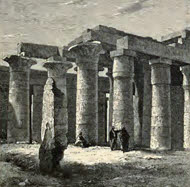What is…
Thebes
also known as: Luxor (modern name), No-Amon, No-A'mon, No, Ta-pe, Waset, City of a Hundred Gates, or City of the Sun
Thebes is the ancient capital of what is called the Middle Empire, in Upper or Southern Egypt. It is located about 500 miles (800 km) south of the Mediterranean Sea along both sides of the Nile River. A pagan religious center, it was “the most venerated city during many periods of ancient Egyptian history.”

Its alternate name No-Amon means “home of Amon.” Amon (aka Amun, Ammon, Amana, Amen, or Amun-Ra) is an Egyptian false god usually depicted with a human body and often with the head of a ram.
Thebes was celebrated for its hundred gates and its vast population. It stood on both sides of the Nile, and included the temples of Karnak and Luxor. In size, it eventually surpassed the city of Memphis, Egypt.
By 1500 BC, Thebes’s population grew to about 75,000. Within another 500 years, it grew to over 120,000. In grandeur and extent it can only be compared to Nineveh.
Q & A
It is mentioned only in the prophecies mentioned above, which point to its total destruction, because of the many evils committed there.
Thus says the Lord God,
“I will also destroy the idols And make the images cease from Memphis [Noph].
And there will no longer be a prince in the land of Egypt;
And I will put fear in the land of Egypt.I will make Pathros desolate,
Set a fire in Zoan
And execute judgments on Thebes [aka No].I will pour out My wrath on Sin [aka Pelusium],
The stronghold of Egypt;
I will also cut off the hordes of Thebes [No].I will set a fire in Egypt;
Sin will writhe in anguish,
Thebes will be breached
And Memphis [Noph] will have distresses daily.” —Ezekiel 30:13-16 NASB
Thebes is located within the modern city of Luxor, Egypt.
Its ruins are still among the most notable in the Nile valley. They have formed a great storehouse of interesting historic remains.
An 1800s Christian traveler to the site recorded his impressions and provided pencil sketches of what he saw.
“As I wandered day after day with ever-growing amazement amongst these relics of ancient magnificence, I felt that if all the ruins in Europe, classical, Celtic, and medieval, were brought together into one center, they would fall far short both in extent and grandeur of those of this single Egyptian city.
…Willing slaves to the vilest superstition, bondsmen to form and circumstance, adepts in every mechanical art that can add luxury or comfort to human existence, yet triumphing abroad over the very Scythians, captives from every quarter of the globe figuring in those long oblational processions to the sacred shrines in which they delighted, after returning to their native Nile—that grave, austere, gloomy architecture, sublime in outline and heavily elaborate in ornament, what a transcript was it of their own character!” —Rev. Dr. Samuel Manning, LLD, The Land of the Pharaohs (1878)
In the 8th century BC, the biblical prophet Joel predicted,
“Egypt will become a waste,
And Edom will become a desolate wilderness,
Because of the violence done to the sons of Judah,
In whose land they have shed innocent blood.But Judah will be inhabited forever
And Jerusalem for all generations.” —Joel 3:19-20 NASB
“The multitude of No”
In Jeremiah 46:25 KJV and Ezekiel 30:15 KJV, the phrase “the multitude of No” is better translated as “Amon of No” or “Amon of Thebes”—the place where the false god Amon had his temple.
The Legacy Standard Bible translation of this verse correctly says,
Yahweh of hosts, the God of Israel, says, “Behold, I am going to punish Amon of Thebes, and Pharaoh, and Egypt along with her gods and her kings, even Pharaoh and those who trust in him. —Jeremiah 46:25 LSB
“Populous No”
In Nahum 3, the King James Version says,
Art thou better than populous No, that was situate among the rivers, that had the waters round about it, whose rampart was the sea, and her wall was from the sea? —Nahum 3:8 KJV
The words “populous No” are correctly translated as “No Amon” in the New King James Version (Nahum 3:8 NKJV; Nahum 3:8 NASB), or simply as “Thebes” in Nahum 3:8 ESV.
More information
- Who is Amon?
- About idolatry and false gods in the Bible
- What is the Nile River? and what is its biblical significance?
 Answers about the pharaohs of the Bible
Answers about the pharaohs of the Bible Answers about Ancient Egypt in the Bible
Answers about Ancient Egypt in the Bible What are the Cities of the Bible? Names, descriptions, locations and types
What are the Cities of the Bible? Names, descriptions, locations and types


